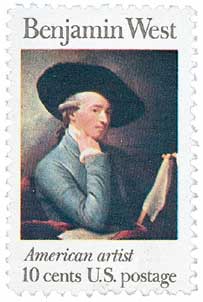
# 1073 FDC - 1956 3¢ Benjamin Franklin
1956 3¢ Benjamin Franklin and Electricity
City: Philadelphia, Pennsylvania
Quantity: 129,384,550
Printed by: Bureau of Engraving and Printing
Printing Method: Rotary Press
Perforations: 10 ½ x 11
Color: Bright carmine
Statesman, Inventor
Death Of Benjamin West
West was born on October 10, 1738, in Springfield, Province of Pennsylvania. The son of an innkeeper, West claimed that as a child he’d learned how to make paint by mixing clay and bear grease from Native Americans. West was generally self-taught when it came to painting and had little formal education.
In 1746, West began working as an artist, producing mostly portraits. A decade later he painted Death of Socrates based on a previous artist’s engraving for William Henry. Though it differed greatly from the original, it has been called “the most ambitious and interesting painting produced in colonial America.” The painting was also an important step in furthering West’s career.
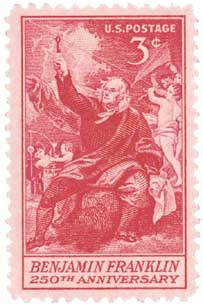
Dr. William Smith saw Death of Socrates at Henry’s home and saw West’s potential. Smith then became West’s patron, helping to get him an education and new connections. Among these connections was British painter John Wollaston, who taught West how to depict the shimmer of silk and satin. West also became close friends with Benjamin Franklin, who was godfather to his second son and painted the dramatic image of him – Benjamin Franklin Drawing Electricity from the Sky, which appeared on U.S. #1073.
In 1760, Smith and William Allen sponsored West on a “Grand Tour” to Italy. While there West met a number of noted artists and studied and painted the works of Italian masters. Three years later West went to England for what was supposed to be a brief stop before returning to America. However, he ended up buying a home there and never went back. In the coming years West grew in popularity in England and became known there as the “American Raphael.”
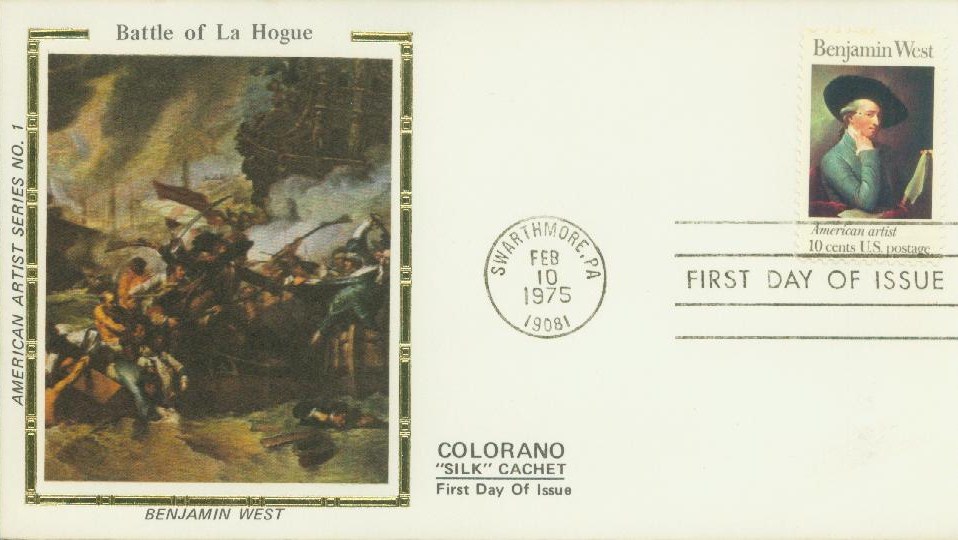
Some of West’s supporters hoped he could receive an annuity so he could abandon portraiture for more ambitious work. They then convinced King George III to meet with him and give him a royal patronage. His first painting for the king was The Departure of Regulus. Then in 1772, the king made West historical painter to the court and later Surveyor of the King’s Pictures.
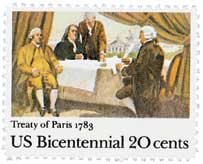
With the king’s patronage, West was also able to produce the larger, more detailed painting for which he would become famous. Most of these paintings were based on historical subjects, such as The Death of General Wolfe and Penn’s Treaty with the Indians.
In 1783, West began a painting commemorating the signing of the Treaty of Paris. It pictures the American delegates, including John Adams. The British representatives refused to sit for the painting, because it represented their country’s loss of the Colonies. The painting was never completed, but was later used as the basis for U.S. #2052.
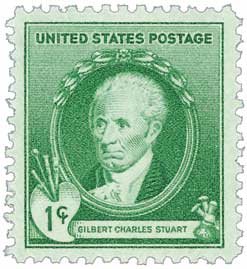
In 1792 West was elected president of the Royal Academy and served until 1805. He was elected again in 1806 and remained in that role until his death. One of the first Americans to study art in England, West was an inspiration to many U.S. artists, and several of them came to London to study with him. They included Samuel Morse, Robert Fulton, Charles Willson Peale, Rembrandt Peale, Gilbert Stuart, and John Trumbull.
Benjamin West died at his London home on March 11, 1820.
Click here to view more West paintings.
1956 3¢ Benjamin Franklin and Electricity
City: Philadelphia, Pennsylvania
Quantity: 129,384,550
Printed by: Bureau of Engraving and Printing
Printing Method: Rotary Press
Perforations: 10 ½ x 11
Color: Bright carmine
Statesman, Inventor
Death Of Benjamin West
West was born on October 10, 1738, in Springfield, Province of Pennsylvania. The son of an innkeeper, West claimed that as a child he’d learned how to make paint by mixing clay and bear grease from Native Americans. West was generally self-taught when it came to painting and had little formal education.
In 1746, West began working as an artist, producing mostly portraits. A decade later he painted Death of Socrates based on a previous artist’s engraving for William Henry. Though it differed greatly from the original, it has been called “the most ambitious and interesting painting produced in colonial America.” The painting was also an important step in furthering West’s career.

Dr. William Smith saw Death of Socrates at Henry’s home and saw West’s potential. Smith then became West’s patron, helping to get him an education and new connections. Among these connections was British painter John Wollaston, who taught West how to depict the shimmer of silk and satin. West also became close friends with Benjamin Franklin, who was godfather to his second son and painted the dramatic image of him – Benjamin Franklin Drawing Electricity from the Sky, which appeared on U.S. #1073.
In 1760, Smith and William Allen sponsored West on a “Grand Tour” to Italy. While there West met a number of noted artists and studied and painted the works of Italian masters. Three years later West went to England for what was supposed to be a brief stop before returning to America. However, he ended up buying a home there and never went back. In the coming years West grew in popularity in England and became known there as the “American Raphael.”

Some of West’s supporters hoped he could receive an annuity so he could abandon portraiture for more ambitious work. They then convinced King George III to meet with him and give him a royal patronage. His first painting for the king was The Departure of Regulus. Then in 1772, the king made West historical painter to the court and later Surveyor of the King’s Pictures.

With the king’s patronage, West was also able to produce the larger, more detailed painting for which he would become famous. Most of these paintings were based on historical subjects, such as The Death of General Wolfe and Penn’s Treaty with the Indians.
In 1783, West began a painting commemorating the signing of the Treaty of Paris. It pictures the American delegates, including John Adams. The British representatives refused to sit for the painting, because it represented their country’s loss of the Colonies. The painting was never completed, but was later used as the basis for U.S. #2052.

In 1792 West was elected president of the Royal Academy and served until 1805. He was elected again in 1806 and remained in that role until his death. One of the first Americans to study art in England, West was an inspiration to many U.S. artists, and several of them came to London to study with him. They included Samuel Morse, Robert Fulton, Charles Willson Peale, Rembrandt Peale, Gilbert Stuart, and John Trumbull.
Benjamin West died at his London home on March 11, 1820.
Click here to view more West paintings.





